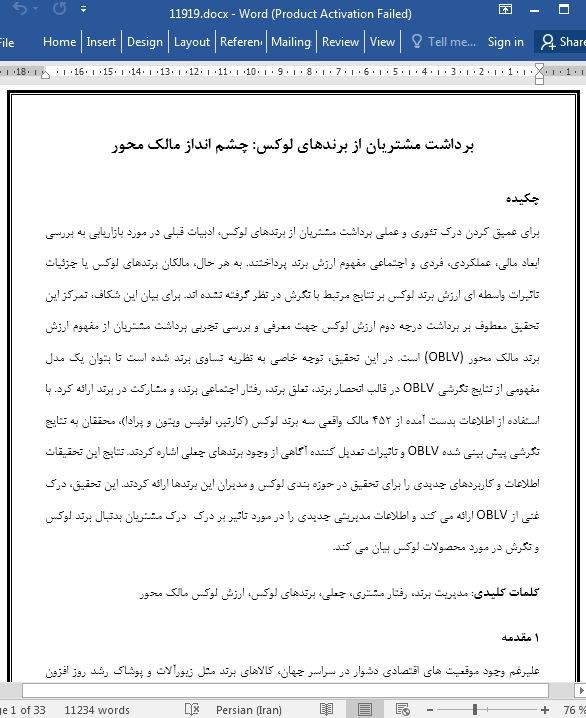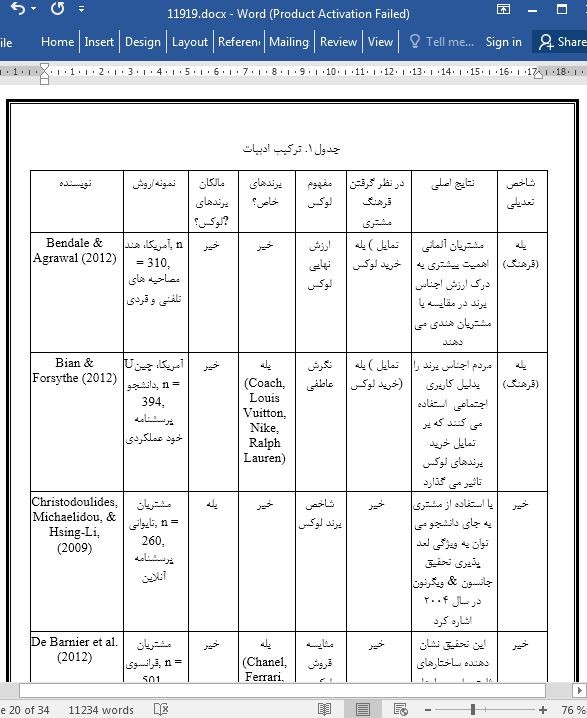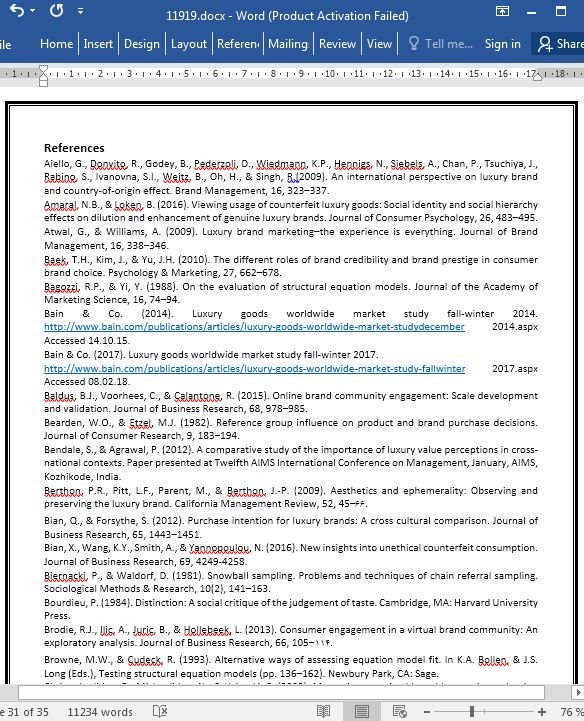
برداشت مشتریان از برندهای لوکس: چشم انداز مالک محور
چکیده
برای عمیق کردن درک تئوری و عملی برداشت مشتریان از برندهای لوکس، ادبیات قبلی در مورد بازاریابی به بررسی ابعاد مالی، عملکردی، فردی و اجتماعی مفهوم ارزش برند پرداختند. به هر حال، مالکان برندهای لوکس یا جزئیات تاثیرات واسطه ای ارزش برند لوکس بر نتایج مرتبط با نگرش در نظر گرفته نشده اند. برای بیان این شکاف، تمرکز این تحقیق معطوف بر برداشت درجه دوم ارزش لوکس جهت معرفی و بررسی تجربی برداشت مشتریان از مفهوم ارزش برند مالک محور (OBLV) است. در این تحقیق، توجه خاصی به نظریه تساوی برند شده است تا بتوان یک مدل مفهومی از نتایج نگرشی OBLV در قالب انحصار برند، تعلق برند، رفتار اجتماعی برند، و مشارکت در برند ارائه کرد. با استفاده از اطلاعات بدست آمده از 452 مالک واقعی سه برند لوکس (کارتیر، لوئیس ویتون و پرادا)، محققان به نتایج نگرشی پیش بینی شده OBLV و تاثیرات تعدیل کننده آگاهی از وجود برندهای جعلی اشاره کردند. نتایج این تحقیقات اطلاعات و کاربردهای جدیدی را برای تحقیق در حوزه بندی لوکس و مدیران این برندها ارائه کردند. این تحقیق، درک غنی از OBLV ارائه می کند و اطلاعات مدیریتی جدیدی را در مورد تاثیر بر درک درک مشتریان بدنبال برند لوکس و نگرش در مورد محصولات لوکس بیان می کند.
1 مقدمه
علیرغم وجود موقعیت های اقتصادی دشوار در سراسر جهان، کالاهای برند مثل زیورآلات و پوشاک رشد روز افزون داشته اند و بازار جهانی برای کالاهای لوکس شخصی به رکورد309 بیلیون دلار در سال 2017 رسیده است و انتظار می رود تا در سال 2010 به 350 بیلیون دلار برسد (باین & کو2017). این رشد قابل توجه می تواند نتیجه فاکتورهایی چون جهانی شدن، موقعیت های رفاه طلبی، ارتباطات دیجیتال، سفرهای بین المللی و تبادلات فرهنگی باشد (اوکاناو 2009). همچنین این عامل می تواند نتیجه تغییرات اجتماعی از جمله پیدایش برندهای " پرستیژ آور" باشد که علاقه مندی بیشتر به برندهای لوکس را در میان مشتریان متوسط (گارزکی & ویستکلاگر 2017، سیلوراستین & فیسک 2008) و دموکراتی شدن برندهای لوکس (وانگ& آهویا 1998) سبب می شود به طوری که وجود برندهای برتر جایگزین انحصار برند می شود. دلیل رشد بازار کالای برند می تواند مواردی چون تامین نیازهای برند لوکس بدون تهدید انحصار برندها (تیان، مک کنی & چون 2010) باشد و مدیران برندهای لوکس باید بدانند که مفهوم یک برند لوکس متناسب برای مشتریان خریدار اجناس لوکس کدامند. همچنین، این محققان باید بتوانند ارزش برندهای لوکس را مطابق با برداشت و نگرش مشتریان نظارت و حفظ کنند. محققان می توانند از طریق توسعه و گسترش شاخص های منسجم درک ارزش برند لوکس به مدیران برندها کمک کنند (میدمن و همکاران 2012).
Abstract
To deepen theoretical and practical understanding of consumers' perceptions of luxury brands, prior marketing literature has investigated the financial, functional, individual, and social dimensions of the luxury value construct. However, it has not considered the owners of luxury brands or detailed the moderated effects of luxury value on related attitudinal outcomes. To address this gap, this study draws on an existing second-order conceptualization of luxury value to introduce and empirically examine an extended conceptualization of the owner-based luxury value (OBLV) construct. The study draws on brand equity theory to offer a conceptual model of the attitudinal outcomes of OBLV in terms of brand loyalty, brand attachment, brand community behavior, and brand engagement. Using unique data from 452 actual owners of three luxury brands (Cartier, Louis Vuitton, and Prada), the authors confirm the predicted attitudinal outcomes of OBLV and reveal moderating effects of awareness of counterfeit existence. Their findings provide new insights and implications for luxury brand research and luxury brand managers. The research provides a richer understanding of OBLV and yields important managerial insights into how to influence luxury-seeking consumers' perceptions of, and attitudes to, luxury brands.
1. Introduction
Despite difficult global economic circumstances, personal luxury goods such as accessories and apparel show continued growth; the global market for personal luxury goods reached record revenues of $309 billion in 2017 and is expected to grow to $350 billion by 2020 (Bain & Co., 2017). This remarkable growth can be the consequence of globalization, wealth-creation opportunities, digital communications, international travel, and cultural convergence (Okonkwo, 2009). It also may be the result of social changes, such as the emergence of “masstige” (mass + prestige) brands that trigger both greater interest in luxury brands among average consumers (Gurzki & Woisetschläger, 2017; Silverstein & Fiske, 2008) and the democratization of luxury (Wong & Ahuvia, 1998), such that broad availability replaces exclusivity. Whatever the reason for the growth of the luxury goods market, to satisfy demands for luxury without threatening the uniqueness and exclusivity of luxury brands (Tynan, McKechnie, & Chhuon, 2010), luxury brand managers need to know what constitutes a luxury brand according to luxury-buying consumers. They need to be able to leverage, monitor, and preserve the value of luxury brands as perceived by those consumers. Scholars can assist luxury brand managers by developing and validating a robust measure of luxury value perception (Wiedmann et al., 2012).
چکیده
1 مقدمه
2. مروری بر ادبیات
2.1 مفهوم لوکس
2.2 ابعاد و نتایج درک ارزش لوکس
3. فرضیه ها
4. روش تحقیق
5. نتایج
6. نتایج و کاربردها
منابع
Abstract
1. Introduction
2. Literature review
2.1. The concept of luxury
2.2. Dimensions and outcomes of perceived luxury value
3. Hypotheses
4. Methodology
5. Results
6. Discussion and implications
References
- اصل مقاله انگلیسی با فرمت ورد (word) با قابلیت ویرایش
- ترجمه فارسی مقاله با فرمت ورد (word) با قابلیت ویرایش، بدون آرم سایت ای ترجمه
- ترجمه فارسی مقاله با فرمت pdf، بدون آرم سایت ای ترجمه



